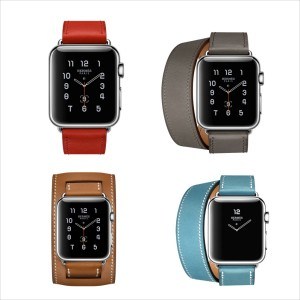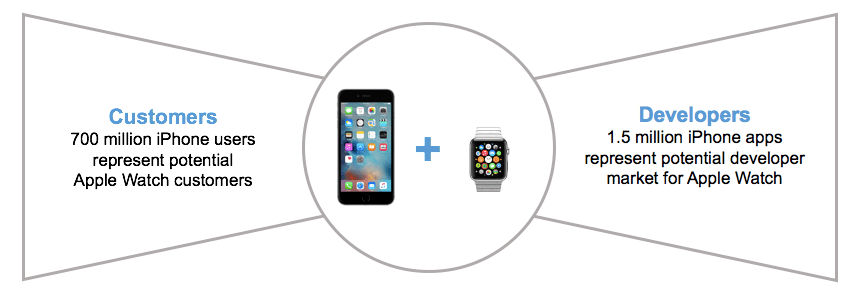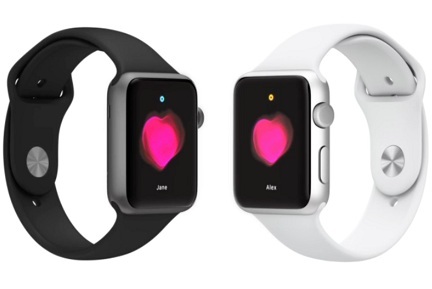Apple Watch: Betting on the Apple Ecosystem

Why Apple Watch will be the leading platform in wearables
As a proud iPhone owner and an extremely satisfied Apple Watch user, I have a positive outlook on the future sales of the Apple Watch. The tech community has been preaching the impending takeover of wearables for the past few years, and Apple is perfectly positioned to not only take over, but to also define the high-end of the market.
Contrary to popular belief, Apple is not too late to dominate wearables. If history has taught us anything about Apple at all, it is the fact that they do not have to invent a category to own it. iPhone overtaking the smartphone category and iPad overtaking tablets are our proof. And the explanation is three fold; Apple is relentless dedication to building products that:
- Seamlessly work together
- Are beautifully designed
- Have an intuitive user interface
You can find all three of these things in the Apple Watch; and that’s why it will win.
700 Million Potential Customers and 1.5 Million Potential Apps
The Apple Watch only works when it is paired with an iPhone. This means that the 700 million iPhone users around the globe and the 1.5 million iPhone apps in the App Store represent a baked in potential market for the product, on both the customer side and developer side.
According to the latest Apple announcement, there are already 8,500 apps for the watch, which has been on the market for less than one year. This rapid app development is a direct function of the successful market for iPhone apps that Apple has built, providing a competitive advantage for its watch platform compared to other wearables in the market.
No one knows the true number of Apple Watch customers to date, but analysts estimate the number to be around 3 million. While this number is considerably lower than expectations (the tech community thought Apple would sell around 2 million units per month) I think it’s too early to count out future success, precisely because of the attractiveness of the watch app market to consumers.
The indirect network effects produced by the ability to do so much more with my watch’s many apps compared to a Fitbit, such as call an Uber, check the weather, get directions, text, control my music, and answer phone calls leads me to suspect that users will gravitate towards Apple’s wearable platform over the competition.
Watch-to-Watch Interactions
Apple Watch also includes ways for owners to interact with one another, driving direct network effects among users, and making the product sticky.
Apple Watch owners can send each other drawings. They can also tap the surface of their watches with their finger tips to sends a taptic touch to another user. The taptic touch doesn’t feel like a vibration – rather it feels like another human truly touching you on your wrist.
Watch users can also send each other their heartbeats. When you receive another person’s heartbeat, the taptic technology lets you feel the exact pulse of the other user. This feature combined with the drawing and tapping described above encourages intimacy among watch wearers.
Unfortunately, only a few of my friends have the Apple Watch; and of those that do, I certainly don’t feel like sending all of them something as intimate as my heartbeat. But as soon as the watch hits a critical mass where more of my friends and family start to have watches, the value of owning one will increase tremendously as we send little drawings to one another, and tap each other’s wrists.
Beautiful Hardware Design
Everyone knows design is the differentiator for Apple in the personal computer market, and the same is true for the watch. Competing wearables manufacturers make plain-looking wristlets, and are focusing on reducing their size so that their clunky appearance does not compete with your daily outfits. They are also going for just one part of the market: fitness fanatics.

Apple, on the other hand, is building a collection of fashion pieces composed of luxurious materials like a proprietary aluminum compound for the Apple Watch Sport, accompanying leather straps for the stainless steel watch, and a 14 karat gold face for the Watch Edition. Perhaps even more interestingly, Apple just announced a partnership with luxury fashion brand Hermes to produce even more Apple Watch faces and straps, doubling down on design not only as a differentiator, but as a new definition of what luxury wearables look like, giving users yet another reason to pick Apple Watch — if their a fitness fanatic that wants the sport version, or a fashionista wanting to rock the leather strap that matches her hand bag.
Intuitive User Interface
The moment I put on my Apple Watch, I knew how to use it. That’s because the watch is a literal extension of the iPhone, which constantly feeds notifications to my wrist via Bluetooth technology using the same icons, imagery, language, and buttons I’ve been trained to recognize on my smartphone. This ease of use lets iPhone users “plug and play” without missing a beat.
Conclusion
The Apple Watch’s integration with the iPhone market of customers and developers who already know how to use and develop for Apple mobile technology, coupled with a luxurious design and intuitive user interface lead me to believe that the Apple Watch will take over the wearables market as the leading platform from sport enthusiasts, to luxury watch wearers — just wait.
Source:
http://fortune.com/2015/07/22/apple-watch-revised-sales/






The steep hardware cost represents the biggest barrier to user adoption. It appears a wide number (1.5M) and variety of apps are already available. Apple just needs to get users to see that the value the watch offered matches its price. This is easier said than done, for it is hard for customers to see the value of the watch and justify its price at the point of sale (the apple store). Most users see the value once they have experienced the watch for a period of time (1-2 weeks). What apple could do to spur user base growth is offer a discount or rebate on the watch (the cheapest watch is priced at about $400). This would make it more accessible to users, but perhaps less profitable for Apple.
The power of network effects are obvious with the Apple Watch. When hanging out with friends, it is only a matter of time before the Apple Watch owners gather together in an exclusive circle to send one another their heartbeats, compare distances walked and time standing up, and talk about the product like they are dating it. Just yesterday my friend forgot her iPhone in her dorm but was still able to receive texts in a different apartment because she had previously connected to the apartment’s WiFi. As these benefits are increasingly noticed, everyone will want to be a part of the Apple Watch club.
I heavily doubt it, and I blame network effects for “why.” The iPhone has been outsold by Samsung phones alone for most of the last five years, never mind the entire Android phone brand. Furthermore, the Apple Watch is fundamentally useless to people like me who have Android phones while at least a selection of Android watches (http://www.theverge.com/2015/8/31/9231293/android-wear-ios-hands-on-video-google-watch-iphone), Pebble watches, and probably others are compatible with iPhones. I am not an expert, so I do not know if Apple locked out the functionality that would allow a Pebble watch owner to see their iPhone’s texts, but I do not imagine it would be hard.
And all of this begs the ultimate question: what does an Apple Watch offer that an iPhone, Android phone, a BlackBerry (yes, I know people who have bought BlackBerries in the last two years) or whatever smartphone does not? If you need to check the time or make a call, a phone already does that. If you forget your watch, you may not notice, whereas I imagine it would take more time to text without your phone. At least Apple is creating Watch-native apps as opposed to ones that mirror the iPhone; without them the Apple Watch is nothing more than an expensive accessory to the iPhone, a way to get more money out of Apple users while most of the world uses other, cheaper, and at times more innovative watches.
That said, in spite of the fact that a minority of people use iOS devices, Apple phones are more profitable (http://www.wsj.com/articles/apples-share-of-smartphone-industrys-profits-soars-to-92-1436727458) and developers believe they get more money from iOS apps than Android apps (http://www.businessinsider.com/android-app-profitability-v-ios-2015-1). As long as this is true developers are more likely to invest in making apps for the Apple family of products before hitting the more populous Android market. That said, the big question may not be “Apple vs. Android.” It is ‘why buy a watch at all.”
Hi Alexander — I agree that Apple won’t sell the most wearables, and that some lower-cost competitor will likely do that. When I said “Apple is perfectly positioned to not only take over, but to also define the high-end of the market” I meant that they will maintain true to their brand, which is to compete on quality and to go after a more luxury consumer than the Android-type of buyer. I predict that there will totally be a world where you have two or three brands of wearables that capture most of the industry’s profits, with Apple leading the luxury category. Apple has never competed on price, and I definitely don’t see them doing so here.
In addition, not opening up their watch platform to other types of phone users is smart because luxury requires exclusivity. The minute the watch becomes too ubiquitous, it loses its value. While this might seem like a strange thing to do in the tech industry, which is all about scaling up at all costs, this strategy makes perfect sense for a fashionable product, and ensures Apple locks in a profitable business model for its hardware.